Rome is a city where it seems there are more fountains and sculptures per square meter than people, so the fact that the Trevi Fountain has become a true icon speaks volumes about its beauty and grandeur.
This Baroque fountain is one of Rome’s most visited attractions for reasons that go beyond its photo-ready, perfectly symmetrical appearance. Like much of Rome, the Trevi Fountain has a history that stretches back hundreds of years, with dramatic twists and turns, of course.
Likewise, a selection of legends and superstitions associated with the fountain, its sculptures, and its meanings make it even more captivating.
In this post, we’ll go through the history of Rome’s Trevi Fountain and what makes it so unique. Additionally, I will give you some tips to visit the Trevi Fountain. You will also find some curiosities you won’t want to miss, including its film appearances.
Trevi Fountain: History, Curiosities & Tips
History of the Trevi Fountain
Long before the Trevi Fountain as we know it existed in its current location, there stood one of the 11 aqueducts that supplied ancient Rome. Specifically, the fountain marks the junction of three roads where the Aqua Virgo ended. This was the shortest of Rome’s aqueducts, stretching about 22 kilometers (approximately 13.7 miles).
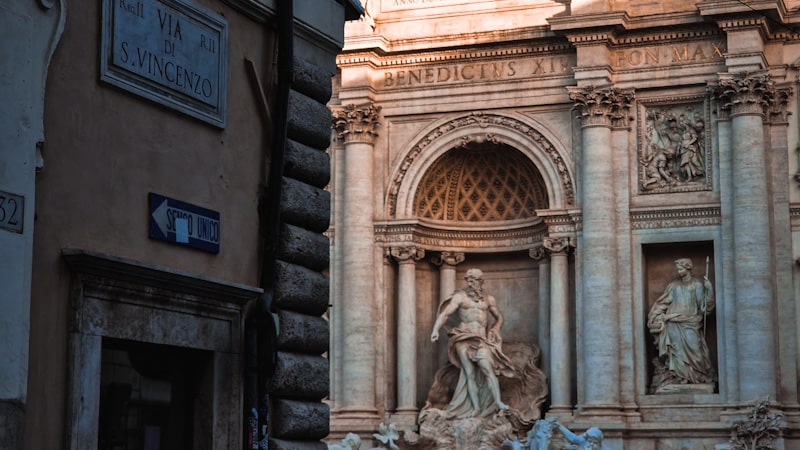
There are two theories about the name of this aqueduct. The first suggests that “Virgo” refers to the purity of the water. Meanwhile, the second theory says the name honors a maiden who showed thirsty soldiers where a spring was. This spring would eventually supply the aqueduct.
Whatever the true origin is, what’s known is that the aqueduct was built by Marcus Agrippa’s orders. The idea was to bring more water to the Baths of Agrippa during the reign of Emperor Caesar Augustus in the 1st century BC (19th century BCE).
The Aqua Virgo was continuously used for about 400 years and was almost entirely underground. Historians like Procopius claim that the Goths attempted to use the aqueduct as a tunnel to invade Rome in 537 AD, damaging this and other Roman aqueducts. Consequently, residents had to depend on the Tiber River for bathing, laundering, drinking, and even as a sewer.
Following the fall of the Roman Empire, further neglect led to aqueducts falling into decay. It wasn’t until 1453 that the Aqua Virgo got repaired. Pope Nicholas V ordered this project, which also included a small and straightforward fountain at its end as a reminder. This practice became customary during the Renaissance.
In 1625, Pope Urban VIII asked the architect Gian Lorenzo Bernini to design a new, more impressive, and monumental fountain. Bernini had the idea of relocating the fountain to the opposite side so that the Pope could view it from the Quirinal Palace. However, this project was abandoned after the pontiff’s death.
Over 100 years later, in 1730, Pope Clement XII announced a competition to redesign the fountain. These competitions were fashionable during the Baroque period; in this case, the legitimate winner was Alessandro Galilei. However, due to protests by Romans who didn’t want someone from Florence in charge of such an important monument, the victory was ultimately awarded to Nicola Salvi.
Construction of the Trevi Fountain began officially in 1732 but was not completed until 1762. This was long after both Pope Clement XII and Salvi had died. Architect Giovanni Pannini was responsible for adding the finishing touches to the project. The fountain is about 20 meters (65 feet) wide and almost 30 meters (nearly 98 feet) high.
Trevi Fountain Sculptures and Their Meaning
The statues in the Trevi Fountain carry various meanings, most of which relate to water. Indeed, the primary theme of the fountain is “taming the waters.”
The central scene of the fountain depicts Oceanus, one of the Titans who preceded the gods. As his name suggests, he ruled over the oceans, rivers, and water in general. This scene, along with the sculptures on its sides, is the work of Pietro Bracci.
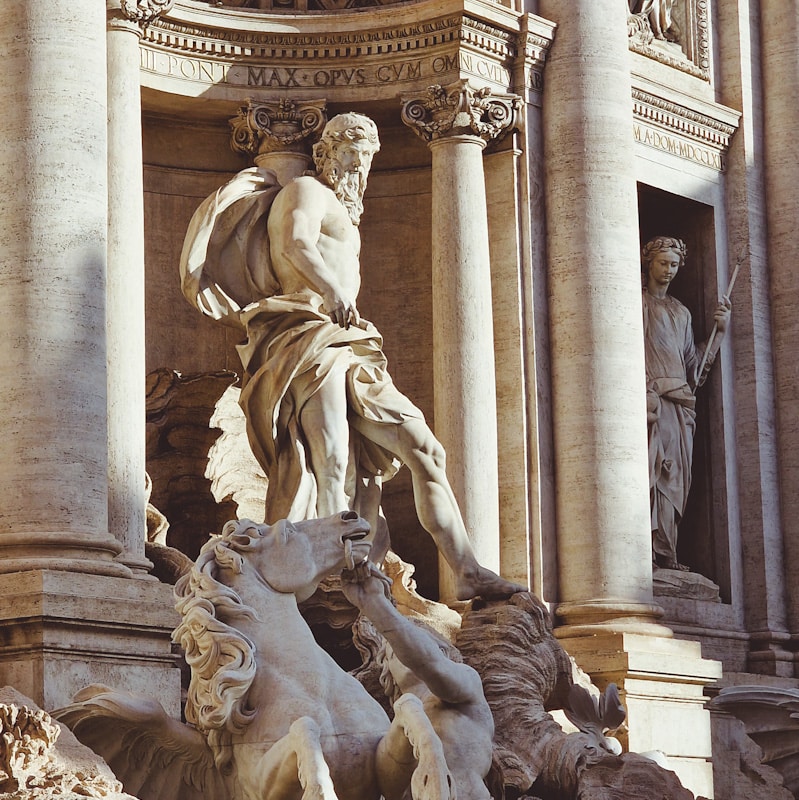
Oceanus emerges at the fountain’s center, perched atop a shell-shaped chariot. On the left, a triton struggles to tame a horse, while another is with an obedient horse on the right. This contrast between the horses simultaneously represents the sea as an untamable force and a calm presence.
Flanking Oceanus are statues that symbolize Health (to the right) and Abundance (to the left). Above Health and Abundance, we can see two bas-reliefs: one depicting the legend of Agrippa approving the aqueduct project, and another showing a young Roman woman pointing out a water source to thirsty soldiers. At the very top of the fountain stands the coat of arms of Pope Clement XII, crowned with four statues representing the four seasons.
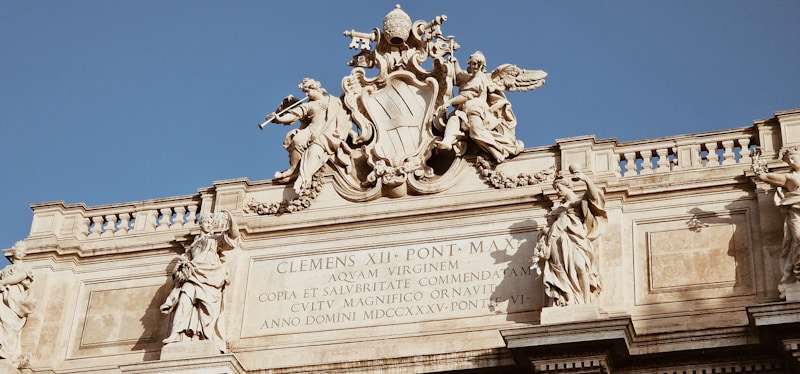
The Trevi Fountain also features sculptures that aim to represent several plants. For example, there are fruit trees as a symbol of abundance and fertility in Rome.
Curiosities and Legends About the Trevi Fountain
Like most of the world’s famous historical landmarks, there is no shortage of legends and curiosities about the Trevi Fountain.
For instance, apparently Nicola Salvi placed a vase sculpture on the right side of the fountain to “get even” with a local barber. Why? Because the barber wouldn’t stop complaining during the construction. The vase, often called the “ace of cups” due to its resemblance to the card, ensured that the barber not view the work. Likewise, tourists would not be able to see his barbershop either. This story is believable because the Baroque style tends to be very intentional. And the vase disrupts the symmetry that dominates the rest of the fountain, so it seems almost out of place.
But the most widespread superstition surrounding Trevi Fountain involves coins. Around 3,000 euros (approximately $3,600 or roughly 2,700 pounds) in coins are thrown into the fountain daily. This isn’t just about tossing coins randomly; there is a whole ritual concerning this tradition. Depending on how many coins you throw and in what manner dictates different outcomes.

To start, if you toss a coin into the Trevi Fountain, you WILL return to the “Eternal City.” This tale seems to come from the archaeologist Wolfgang Helbig. Helbig had to leave the city before being able to visit all its essential attractions. So, he threw the first coin as a symbol.
Over the years, more meanings have been attached to this custom. For instance, if you throw two coins into the fountain, a new romance awaits, but if there are three, the outcome can be more ambiguous: marriage, divorce, or good luck—only if you toss the coins at the same time with your right hand over your left shoulder.
The money thrown into the fountain is for charities, including ones creating food banks for Romans in need.
On another note, the Fontana di Trevi is one of the most famous fountains in the world and by far the best-known in Rome and Italy. Thus, it’s not surprising that it has appeared in or inspired iconic moments in film, including:
- Roman Holiday: Starring Audrey Hepburn and Gregory Peck, this 1953 film catapulted Hepburn to stardom and earned her an Oscar for Best Actress. Throughout the plot, the lead pair visits a few Roman attractions, including the iconic Trevi Fountain.
- Three Coins in the Fountain: This 1954 film is based on a ‘52 novel titled Coins in the Fountain by John H. Secondari. The movie, filmed in Rome, tells the story of three American women seeking love in the “Eternal City.” Frank Sinatra sings the main theme of the soundtrack, also called Three Coins in the Fountain.
- La Dolce Vita: In this 1960 film, Sylvia, played by Anita Ekberg, takes a dip in the Trevi Fountain, creating one of the most memorable moments and scenes in Italian cinema. This scene has been recreated and paid tribute to in other movies like the 2005 Argentine-Spanish production Elsa y Fred, where actress China Zorrilla enters the fountain.
- The Lizzie McGuire Movie: In the 2003 Disney movie about Lizzie McGuire, portrayed by Hilary Duff, she and her classmates travel to Rome. In one scene, you can see them tossing coins into the fountain, as one does because when in Rome…
Tips to Visit the Trevi Fountain in Rome
The best advice I can give you to vist the Trevi Fountain in Rome is to get there as early as possible. And yes, I know waking up early on vacations doesn’t sound like fun at all. But, being an early bird, you’ll have more space and time to appreciate it and to take photos and videos before the rest of the tourists arrive. Moreover, even when the fountain’s water is off in the early morning, it is still beautiful and awe-inspiring.
You might also benefit from booking a hotel close to Rome’s Trevi Fountain. This way, you can get there earlier without spending time and money on public transportation.
To reach the Trevi Fountain, you can take Line A (orange) of the metro and get off at Barberini Station. From Barberini, you only need to walk about five minutes through Via del Tritone and then Via Poli to reach the fountain.
By bus, the closest stops are L.go Chigi, about a 4-minute walk away; Corso/Minghetti, approximately a 5-minute walk; and P.za Venezia, at an 8-minute distance. The bus line will depend on where you are staying or your current location, but you’ll be able to choose from C3, N5, N46, 51, 52, 53, 62, 63, 71, 80, 83, 85, N90, 100, 117, 119, 160, N201, 492 and N543.
This fountain is a must-see during your first trip to Rome. Additionally, many Roman luxury experiences are nearby, which makes it one of the best areas to stay in Rome.




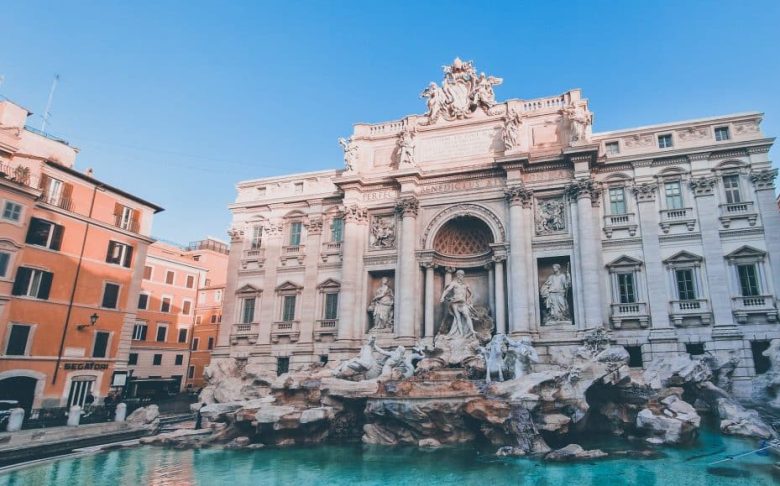
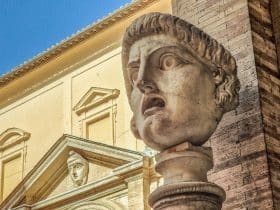
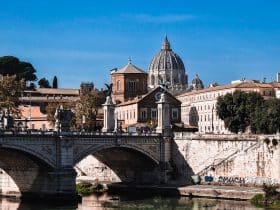



















Leave a Reply
View Comments